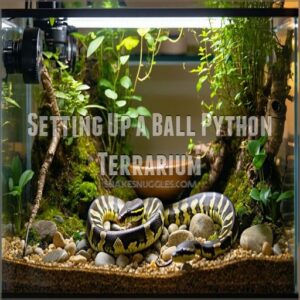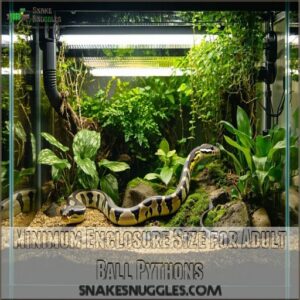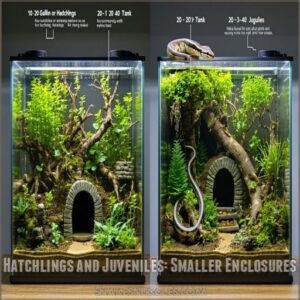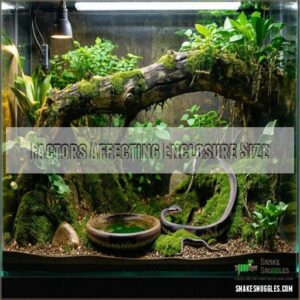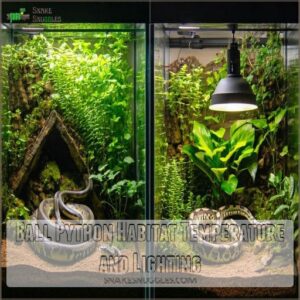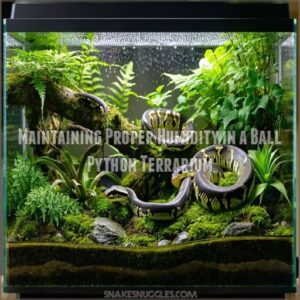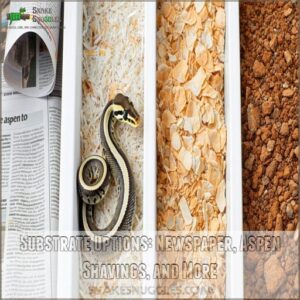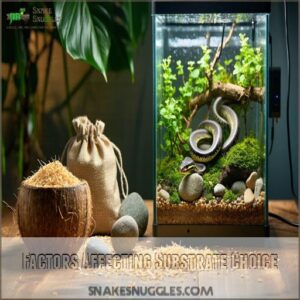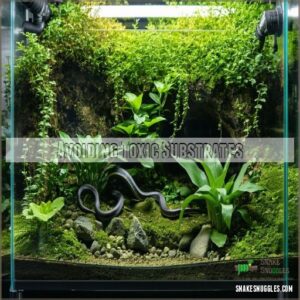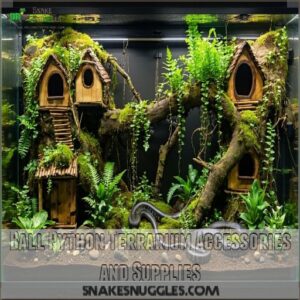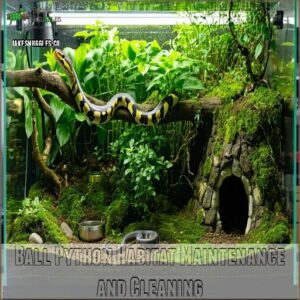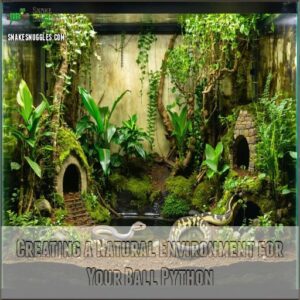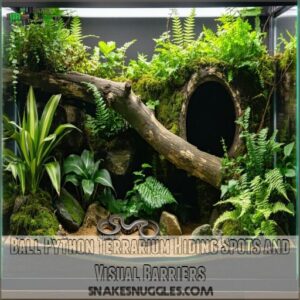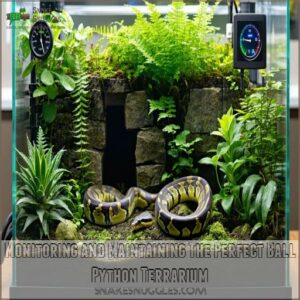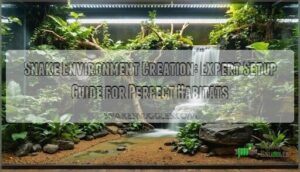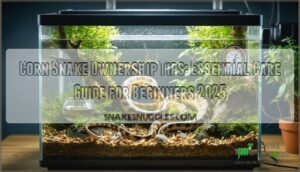This site is supported by our readers. We may earn a commission, at no cost to you, if you purchase through links.
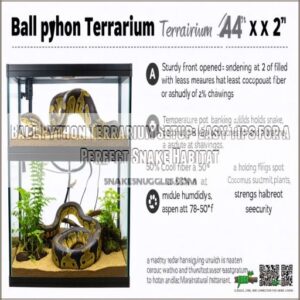 Setting up a ball python terrarium is all about creating a cozy, safe, and natural space.
Setting up a ball python terrarium is all about creating a cozy, safe, and natural space.
You’ll need a sturdy enclosure—at least 48" x 24" x 24" for an adult—with front-opening doors for easy handling.
Add substrates like coconut fiber or aspen shavings to hold humidity (50-60%).
Keep the temperatures comfy with a gradient: 90°F at the basking spot and 78-80°F on the cool end.
Toss in hiding spots, branches, and artificial plants to mimic their wild home and reduce stress.
Don’t forget a water dish and tools like a thermometer and hygrometer to monitor conditions.
Curious about enrichment ideas?
Table Of Contents
- Key Takeaways
- Setting Up a Ball Python Terrarium
- What Size Terrarium Does a Ball Python Need
- Ball Python Habitat Temperature and Lighting
- Maintaining Proper Humidity in a Ball Python Terrarium
- Choosing The Best Substrate for a Ball Python Terrarium
- Ball Python Terrarium Accessories and Supplies
- Ball Python Habitat Maintenance and Cleaning
- Creating a Natural Environment for Your Ball Python
- Ball Python Terrarium Hiding Spots and Visual Barriers
- Monitoring and Maintaining The Perfect Ball Python Terrarium
- Frequently Asked Questions (FAQs)
- How do I set up a ball python terrarium?
- Can a ball python live in a 40 gallon terrarium?
- How do I set up a habitat for a ball python?
- What kind of terrarium do ball pythons need?
- How do you make a terrarium look like a ball python?
- Do ball python terrariums need a hideout?
- How Often Should I Clean My Ball Python’s Enclosure?
- What is the Best Way to Feed My Ball Python?
- How Often Should I Handle My Ball Python?
- What Plants Are Safe to Have in a Ball Python Enclosure?
- Conclusion
Key Takeaways
- Make sure your ball python’s terrarium is at least 48" x 24" x 24", with a temperature gradient (90°F basking spot and 78-80°F cool side) and 50-60% humidity for optimal comfort.
- Use safe and humidity-retaining substrates like coconut fiber or aspen shavings, and avoid toxic materials like cedar shavings or sand.
- Provide essential accessories like two hides (warm and cool sides), a sturdy water dish, and monitoring tools like a thermometer and hygrometer.
- Add enrichment like branches, cork bark, and artificial plants to mimic a natural habitat and reduce stress while fostering exploration.
Setting Up a Ball Python Terrarium
Setting up a ball python’s terrarium might feel tricky at first, but it’s all about creating a cozy, natural space they’ll thrive in.
With the right enclosure, proper heat, and thoughtful accessories, you’ll have a happy snake that feels right at home.
Essential Components for a Healthy Environment
Creating the ideal ball python habitat isn’t rocket science, but nailing the basics is key to keeping your snake happy and healthy.
A proper terrarium setup mimics their natural environment and keeps their well-being in check.
Here’s what you’ll need:
- Heat sources to maintain that warm sweet spot (remember, snakes love cozy corners).
- Humidity control systems for ideal moisture levels—think 55-60% with spikes for shedding.
- A quality substrate for burrowing and holding humidity, like coconut fiber.
- Lighting to support natural day-night cycles (nothing fancy, just the basics).
- Hiding spots for stress-free lounging—snakes need their alone time too!
Get these right, and you’re golden!
Choosing The Right Enclosure Size and Type
Picking the right terrarium size for your ball python is like choosing the perfect home – it needs to fit their lifestyle and growth.
A good rule: match the snake’s length to your enclosure dimensions. Adults thrive in at least a 48” x 24” x 24” setup (think cozy studio apartment).
For enclosure materials, glass tanks are great for visibility but struggle with humidity control, while PVC enclosures are champs at holding in heat and moisture.
Front-opening designs make feeding and cleaning less of a juggle, and strong ventilation systems keep fresh air flowing, reducing health risks.
It’s all about balancing function, comfort, and a solid terrarium setup guide.
Creating a Natural Habitat
Think of your ball python’s terrarium as its little slice of West Africa – cozy yet wild.
Start by adding plant decor like artificial snake plants or philodendrons. They’re perfect for mimicking a natural habitat for ball python while giving your snake some privacy.
Toss in rock features near your heating elements for basking and layer the space with cork bark and branches. These create natural textures for climbing and exploring.
For the base, choose soil that holds humidity well – this helps maintain great soil quality. Add a small water dish as a simple water element your snake can use for hydration.
This balance creates an engaging, secure ball python terrarium setup.
What Size Terrarium Does a Ball Python Need
Picking the right terrarium size isn’t just about space—it’s about giving your ball python room to thrive.
Whether you’ve got a tiny hatchling or a hefty adult, their enclosure needs to match their growth and activity level, which involves considering the ball python.
Minimum Enclosure Size for Adult Ball Pythons
How big should your ball python’s home be? Adults need enough space to stretch, roam, and feel secure.
Here’s the scoop:
- A 48" x 24" x 24" tank volume is the minimum for a happy, full-grown ball python.
- Aim for a terrarium size about two-thirds of the snake’s length for both comfort and growth.
- Front-opening enclosures are great for safe, easy handling while reducing stress.
For ideal care, researching reptile care is essential to create a suitable environment.
Remember, python growth is no joke—bigger snakes need more adult space.
The ideal ball python setup? Spacious, cozy, and just right for your reptile buddy!
Hatchlings and Juveniles: Smaller Enclosures
Starting with a small enclosure helps your young ball python feel cozy and safe—hatchling care 101!
A 10-20 gallon tank suits hatchlings, while juveniles enjoy 20-40 gallons.
Keep hide boxes snug, matching their size to reduce stress.
Tiny tank decor can include smooth branches and small water bowls.
Young snake habits thrive when everything feels just right in their compact ball python terrarium!
Factors Affecting Enclosure Size
Getting the right terrarium size for your ball python is about more than just their length—it’s their entire lifestyle.
A comfortable snake means a happy snake.
When sizing up, consider:
- Age and growth: Hatchlings need smaller spaces; adults need more room.
- Predicted size: Females typically grow larger than males.
- Activity level: Some explore more than others; give them room to roam.
- Setup style: A naturalistic terrarium takes more space than a minimalist vibe.
- Future plans: If breeding’s in your cards, housing capacity matters.
Think of it as designing their perfect “dream home”.
Ball Python Habitat Temperature and Lighting
Keeping your ball python’s habitat at the right temperature and lighting isn’t just important—it’s essential for their health and comfort.
With a warm zone, a cool side, and a little help from reliable heat sources, you’ll create a cozy space your snake will thrive in.
Temperature Gradient and Zones
Your ball python thrives with proper temperature zones—think of it as setting up cozy thermal layers.
You’ll need a gradient system for natural thermoregulation.
Set the basking surface to 90-92°F while keeping the warm side around 88-96°F.
The cool zone, on the other hand, stays comfortable at 78-80°F.
To learn more about ideal ball python temperature conditions, research and understand the specific needs of your pet to make informed decisions.
| Purpose | Placement | ||
|---|---|---|---|
| Basking Surface | 90-92 | Warming up after rest | Heat lamp area |
| Warm Zone | 88-96 | Digestive comfort | Half the tank |
| Cool Zone | 78-80 | Cooling off when needed | Opposite heat |
| Ambient Temp | 80-82 | General climate | Entire enclosure |
This mix of heat distribution helps you nail temperature control effortlessly!
Heat Sources: Overhead Heat Sources and Heat Pads
Keeping your ball python cozy means nailing the heating setup.
Use heat lamps like ceramic emitters or basking bulbs to warm a hot spot (88–96°F).
Pair this with heat mats, placed under one-third of the enclosure, and connect them to a thermostat for precise thermal control.
Understanding ball python heat is essential for creating an ideal environment.
These heating elements work together to create the perfect temperature gradient, so your snake can bask or chill as needed, staying healthy and stress-free.
Ball Python Habitat Lighting: Ambient Light is Sufficient
Ball pythons don’t need fancy reptile lighting setups. A simple 12-hour lighting cycle with ambient light does the trick.
Bright lights? Not their thing—they’re nocturnal and love dim spaces. Skip UVB; they don’t need it. Think soft, natural light over glaring spotlights.
- Lighting options: Overhead or nearby room lamps.
- No UVB alternatives: Totally fine!
- Dimming systems: Great for nighttime.
- Color temperature: Keep it cozy and subtle.
Maintaining Proper Humidity in a Ball Python Terrarium
Keeping the humidity in your ball python’s terrarium between 50-60% isn’t just important; it’s essential for their health.
If the air gets too dry, your snake might struggle to shed properly or stay hydrated, and nobody wants a cranky, crinkly python!
Humidity Requirements: 50-60% Relative Humidity
Nailing the right humidity levels in your ball python’s terrarium keeps them healthy and happy.
Aim for 50-60% relative humidity—think of this as their comfort zone. Use a digital hygrometer to monitor moisture levels and place it near the substrate, where your snake hangs out most.
Check readings twice daily to keep tabs on changes. Simple tricks like adding a large water bowl or a fogging system can help with humidity control.
A well-calibrated hygrometer guarantees you’re meeting their exact humidity requirements without hassle.
Benefits of Proper Humidity: Facilitating Shedding and Hydration
Keeping humidity levels between 55-65% isn’t just essential—it’s like handing your ball python a VIP pass to smooth shedding and glowing skin health.
Proper moisture levels keep their old skin peeling off effortlessly. Plus, staying hydrated helps digestion run like clockwork.
Need help? Humidifiers or mist options can make humidity control easy. Think of it as setting up a spa retreat for stunning scales and happy shedding, which can be considered a spa retreat for your pet, and helps with smooth shedding.
Signs of Low Humidity: Difficulty Shedding and Dehydration
Low humidity in your ball python terrarium can trigger serious issues that your snake absolutely doesn’t need.
Watch out for these signs:
- Shedding issues, like stuck shed clinging to the eyes or tail tip.
- Skin problems, such as wrinkled or dull skin that’s lost its natural sheen.
- Dehydration symptoms, including sunken eyes or a flaky, dry nose.
Grab a humidity meter and adjust humidity levels using humidifiers or misting to dodge these problems—it’s all about smooth shedding and happy scales!
Choosing The Best Substrate for a Ball Python Terrarium
Choosing the right substrate for your ball python’s terrarium is more than just picking what looks nice—it affects their health and comfort.
You’ll want something that holds humidity well, is safe for your snake, and makes cleaning up those “little messes” a breeze.
Substrate Options: Newspaper, Aspen Shavings, and More
When setting up your ball python terrarium, substrate options matter.
From easy-to-clean newspaper to moisture-retaining coconut fiber, you’ve got choices!
Here’s a snapshot: Researching the best ball python substrate is essential for creating a suitable environment.
| Substrate | Humidity Control | Snake Safety | Environmental Impact |
|---|---|---|---|
| Newspaper | Low | Very Safe | Recyclable |
| Aspen Shavings | Moderate | Moderate (Ingestion Risk) | Compostable |
| Coconut Fiber | High | Very Safe | Eco-Friendly |
| Cypress Mulch | High | Safe (Use Carefully) |
Choose what best fits your snake’s needs!
Factors Affecting Substrate Choice
Picking the perfect substrate boils down to balancing key factors.
Substrate Moisture and Humidity Control matter most—options like coconut fiber lock in moisture, while paper towels don’t.
Ball python Substrate Depth should suit their size; bigger snakes need deeper bedding.
Think about your budget too—Aspen shavings are affordable, while premium reptile carpet and cypress mulch look natural but cost more.
Prioritize Snake Safety by sticking to safe substrate options with no harsh chemicals.
Avoiding Toxic Substrates
Some substrate materials spell trouble for your snake.
Keep your ball python healthy by avoiding these:
- Cedar shavings: Toxic oils can mess up your snake’s breathing.
- Sand: It’s a bacteria magnet and can stick in their mouth.
- Reptile carpet: Traps bacteria and might snag teeth—nobody wants that.
- Fine-textured options: These often get stuck in lips or mouths, causing irritation.
Stick to safe materials like aspen shavings or coconut fiber!
Ball Python Terrarium Accessories and Supplies
Your ball python’s terrarium isn’t just a home—it’s a space where the right accessories can keep them healthy and stress-free.
From cozy hide boxes to sturdy climbing branches, each item plays a key role in creating a habitat that’s both functional and fun for your snake.
Essential Accessories: Hide Boxes, Water Dish, Thermometer, and More
Your ball python’s terrarium isn’t complete without two sturdy hide boxes, one on the warm side and one on the cool.
Snake hides made from cork or wood add a natural vibe to the setup. A heavy ceramic water dish is great for soaking, but make sure it’s hard to tip—spilled water’s no fun.
Keep an eye on things with a trusty thermometer and hygrometer to track temperature and humidity.
When selecting a Ball Python Hide, consider the material and size to guarantee it provides the best environment for your pet.
| Accessory | Purpose | Pro Tip |
|---|---|---|
| Hide Box Designs | Privacy and Security | Aim for a snug fit—snakes like tight spaces. |
| Water Dish | Hydration and Shedding Aid | Use filtered water for better water quality. |
| Thermometer | Monitoring Temperature | Regular thermometer calibration promotes accuracy. |
Providing Variety and Enrichment: Hiding Places and Climbing Branches
Give your ball python’s terrarium some flair with enrichment ideas that keep them active and comfy.
Mixing hiding places and climbing structures adds personality to their habitat. Incorporating ball python enrichment techniques can help create a stimulating environment.
- Place cork bark at different levels for fun branch placement.
- Add wood hollows or a cozy hide box to foster security.
- Use grapevine branches for natural terrarium design and exploration.
Encouraging Exploration and Reducing Stress
Making a ball python terrarium exciting is simpler than you think! Incorporate hiding places and creative elements to encourage snake behavior.
Here are quick habitat variety ideas:
| Accessory Type | Purpose | Benefits | Setup Tips |
|---|---|---|---|
| Cork Bark Tubes | Climbing & Hiding | Stress reduction | Position diagonally |
| Branch Networks | Exploration | Strengthens muscles | Anchor securely |
| Rock Formations | Shedding aid | Adds basking spots | Leave accessible space |
| Snake-Safe Plants | Environmental Enrichment | Boosts humidity | Use in corners carefully |
Mix it up! Rearranging your ball python’s reptile terrarium monthly sparks curiosity, offering fresh exploration techniques.
Ball Python Habitat Maintenance and Cleaning
Keeping your ball python’s habitat clean isn’t just about keeping things tidy—it’s essential for their health and happiness.
Regular maintenance, like removing waste and uneaten food, prevents bacteria buildup and keeps your snake feeling its best, which is crucial for their overall happiness.
Regularly Cleaning and Disinfecting The Enclosure
Keeping your snake’s space sparkling clean isn’t just about looks—it’s about their health and happiness.
A ball python’s terrarium maintenance is easy if you follow a regular cleaning routine:
- Spot clean waste and debris every few days to keep enclosure hygiene in check.
- Sanitize hides, décor, and bowls weekly using reptile-safe disinfectant methods.
- Deep clean the cage monthly—scrub every corner with cleaning supplies and rinse thoroughly.
Fresh living space, happier python!
Removing Waste and Uneaten Food Promptly
Waste removal’s a daily must for great cage maintenance.
Spot-checking for droppings or sheds keeps enclosure hygiene of the highest standard.
Skip the stink by removing uneaten prey within 4 hours—it’s a recipe for bacteria otherwise.
Use feeding tongs for safe food disposal methods.
Quick terrarium maintenance boosts snake health and makes your pet feel like royalty.
Simple reptile care tips, huge payoff!
Maintaining a Clean Water Dish
A clean water dish is a must in your ball python terrarium.
Check it daily—nobody likes stale water, including your snake.
Use hot water and mild soap for dish cleaning, scrubbing away bacteria.
Rinse thoroughly because leftover soap isn’t snake-safe.
Refill with fresh, dechlorinated water and place it somewhere accessible.
Good water quality equals better hydration and happier reptile care.
Creating a Natural Environment for Your Ball Python
Creating a natural environment for your ball python means mimicking the grassy savannas and forests of West Africa, where they thrive.
Skip rainforests or deserts—your snake’s ideal habitat is warm, humid, and full of cozy hiding spots.
Native to West African Coast and Central Africa
Imagine your ball python’s ancestors roaming the West African paradise, rich with warm grasslands and savannas.
Their wild habitat stretched through coastal ecosystems and peaceful burrows.
Picture it: Understanding their natural habitat is key to replicating their environment.
- Rodent burrows: Cozy shelters from the sun.
- Savannas: Open spaces full of life.
- Nocturnal adventures: Hunting quietly under moonlit skies.
Creating a similar ball python terrarium brings their native habitat to life.
Preferred Habitats and Behavior
Ball pythons are like introverts with a love for cozy spaces.
They’re nocturnal explorers, staying active at night and retreating to hideouts during the day.
If your snake’s constantly hiding or refuses food, it could be stressed.
Stick to a natural terrarium layout with snug hiding spots that mimic their burrowing instincts.
Relaxed snakes mean a thriving ball python habitat!
Avoiding Rainforests, Deserts, and Arid Places
Your snake’s not a fan of extremes.
Rainforests with their wet, dense air? Too much. Deserts and arid areas? Way too dry.
Instead, think savannas—warm, humid, and balanced. It’s all about matching your ball python’s natural climate zones to avoid environmental risks.
A proper snake terrarium setup mimics their ideal ecosystem balance, ensuring your ball python’s habitat feels just right, not like a rainforest sauna or desert fry-pan, which is all about finding the perfect ecosystem balance.
Ball Python Terrarium Hiding Spots and Visual Barriers
Your ball python needs cozy hiding spots and visual barriers to feel safe and reduce stress.
Think of it like giving them their own little “room” where they can unwind—after all, nobody likes being watched all the time, it’s about giving them a sense of privacy.
Types of Hiding Spots and Visual Barriers
When setting up your ball python terrarium, hiding spots and visual barriers are a must-have for their comfort.
Rock caves or log hides mimic natural shelters and help your snake feel secure.
Want to add personality? Try making DIY corner shelters using simple materials.
Plant barriers aren’t just for looks—they also reduce stress by creating privacy.
Even water hides, like shallow dishes, let your python soak in peace.
The addition of rock caves can greatly enhance the terrarium’s natural ambiance.
These terrarium accessories guarantee your snake has a cozy, stress-free sanctuary.
Placement and Arrangement of Hiding Spots
Let’s talk Hiding Spot Placement—turn your ball python terrarium into a cozy retreat! Snakes love options, so mix up your hiding spots: damp hides, snug corners, and more open shelters.
Place at least two hides—one on the warm side and one on the cool side—for thermal variety and comfort. Add visual barriers like plants or decor to reduce stress and create privacy.
Watch your snake’s behavior; if a hide’s ignored, tweak its spot. Think of this as customized interior decorating for your snake’s ideal terrarium layout!
- Warm and Cool Placement: Balance temperatures.
- At Least Two Hides: More for choice.
- Visual Barriers: Mimic natural cover.
- Dark/Snug Spaces: Security matters.
- Observe Behavior: Adjust as needed.
Monitoring and Maintaining The Perfect Ball Python Terrarium
Keeping your ball python’s terrarium in tip-top shape isn’t hard, but it does take consistency.
By monitoring temperature, humidity, and cleanliness regularly, you’ll keep your snake healthy and stress-free.
While avoiding little surprises—like a stinky enclosure!
Temperature and Humidity Monitoring
Keeping your ball python cozy takes effort.
Temperatures and humidity levels need constant checks—it’s like babysitting but with thermometers and hygrometers.
Use a thermometer calibration routine to guarantee accuracy; daily readings are non-negotiable.
Humidity sensors help track moisture control around 55-65%.
Record temperature logs for clarity when things feel off.
Place heat sources strategically to balance gradients, from a warm basking spot to cooler edges.
Steady your hand with patience—your serpent’s comfort depends on your monitoring skills, including maintaining the right temperature.
Cleaning and Maintenance Schedules
How do you keep your ball python’s terrarium fresh and safe? Stick to a simple terrarium maintenance schedule.
Understanding the schedule involves recognizing the importance of regular tasks:
- Daily: Remove waste and uneaten food – it’s like taking out the trash for your snake.
- Weekly: Refresh water, swap soiled substrate, and tidy hides.
- Monthly: Deep-clean with disinfection methods and replace substrate entirely.
Understanding ball python pet care is essential for a healthy environment.
Use proper cleaning tools to follow good reptile husbandry!
Adjusting The Environment as Needed
Sometimes your ball python’s setup needs tweaks to match changing conditions.
If seasonal temperature fluctuations hit, adjust the heat source to keep their comfort flawless.
Boost humidity levels during shedding cycles with misting or damp substrate.
Switch things up—rearrange hides or add enrichment for curiosity.
Keep substrate fresh, lighting adjustments steady, and air quality healthy for a thriving serpent companion.
Frequently Asked Questions (FAQs)
How do I set up a ball python terrarium?
Start with a 40-gallon tank minimum.
Add a heat mat for warmth, a thermostat to control it, and two hides—one on each side.
Use coconut fiber or aspen bedding and maintain 60% humidity.
Can a ball python live in a 40 gallon terrarium?
A 40-gallon terrarium works for most adult ball pythons, but bigger is better!
Females, being larger, might outgrow it, so consider upgrading to a 60-gallon tank for more room to roam comfortably.
How do I set up a habitat for a ball python?
Think cozy jungle, not cramped box.
You’ll need a 40–60-gallon tank, a snug hide on each side, a heat mat for warmth, substrate like coconut fiber.
And perfect humidity—55-65%—to keep them thriving.
What kind of terrarium do ball pythons need?
Your ball python needs a secure, roomy terrarium—at least 40 gallons for adults, ideally 60 gallons.
Glass or PVC enclosures with proper ventilation work best, keeping humidity, temperature, and hiding spots cozy and just right.
How do you make a terrarium look like a ball python?
It’s funny how nature inspires design.
To make a terrarium look like a ball python’s habitat, add natural touches like driftwood, hides, plants, and earthy substrates like coconut fiber.
Keep it cozy but functional!
Do ball python terrariums need a hideout?
Hiding spots aren’t just optional—they’re essential.
Ball pythons love snug, dark spaces to feel safe.
Add at least two hides, one on the warm side and one on the cooler side of the enclosure.
How Often Should I Clean My Ball Python’s Enclosure?
Let’s face it—your ball python’s home gets messy.
Spot clean waste and uneaten food daily, swap out substrate monthly, and schedule a deeper clean every 1-2 months to keep things fresh and safe.
What is the Best Way to Feed My Ball Python?
Feed your ball python pre-killed or frozen-thawed rodents to guarantee safety.
Warm the prey to room temperature and use tongs to avoid accidental bites.
Offer food every 7-14 days based on its size and age.
How Often Should I Handle My Ball Python?
Handling your ball python feels like holding a slow-moving river of muscle—but don’t overdo it.
Limit handling to 1-2 times weekly, letting them adjust between feedings.
Always prioritize gentleness and their comfort.
What Plants Are Safe to Have in a Ball Python Enclosure?
Stick to hardy, non-toxic plants like pothos, snake plants, or bamboo.
They’re tough enough to handle humidity and look great, but skip anything sharp or toxic—your ball python doesn’t need any drama.
Conclusion
Let’s face it, setting up a ball python terrarium isn’t rocket science—but skip the steps, and your scaly buddy’s gonna have opinions (hint: they involve stress and a bad shed).
Stick to cozy temperatures, 50-60% humidity, and a solid hide spot, and you’re golden.
Keep it natural with the right substrate, toss in some branches, and watch your snake chill like it’s on vacation. Nail this setup, and you’ll have a happy ball python lounging like royalty.
- https://reptilesupply.com/blogs/how-to-guides/how-to-set-up-a-ball-python-enclosure
- https://mysnakepet.com/ball-python-terrarium-setup/
- https://dubiaroaches.com/blogs/how-to-guides/how-to-set-up-a-ball-python-terrarium
- https://www.terrariumquest.com/ball-python/habitat/
- https://www.everythingreptiles.com/ball-python/

